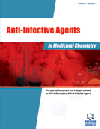Anti-Infective Agents in Medicinal Chemistry - Volume 9, Issue 1, 2010
Volume 9, Issue 1, 2010
-
-
Generation and Analysis of Interaction Energy Maps of p-Substituted Benzoic Acid N'-(5-Nitrothiophen-2-yl)Methylenehydrazides Active Against Multidrug-Resistant Staphylococcus aureus
More LessAuthors: Andrea Masunari, Ieda Y. Sonehara and Leoberto Costa TavaresStudies in 3D molecular fields generally contain a large amount of data, some of which are redundant or not relevant. The program Volsurf, a quite fast method, is able to compress the relevant information present in 3D molecular structures into a few descriptors that represent the physicochemical properties. In this study eighteen p-substituted benzoic acid N'-(5-nitrothiophen-2-yl)methylenehydrazides with antimicrobial activity were evaluated against multidrug-resistant Staphylococcus aureus, correlating the three-dimensional characteristics of the ligands with their respective bioactivities. Structures were obtained by CORINA program, and using a GRID force field, the following probes have been used to generate their corresponding 3D interaction energies (MIFs): water, DRY, carbonyl oxygen atom and amide NH group. Calculations using Volsurf resulted in a statistically consistent model with 48 structural descriptors showing that hydrophobicity is a fundamental property in the analyzed biological response. Results have shown the potential of studied compounds as alternatives to the treatment of infections caused by multidrug-resistant Staphylococcus aureus.
-
-
-
Effective Antimicrobial and Anti-Endotoxin Activity of Cationic Peptides Based on Lactoferricin: A Biophysical and Microbiological Study
More LessBacterial endotoxins (lipopolysaccharide, LPS) from the outer leaflet of the outer membrane of Gram-negative bacteria are among the most effective natural compounds in triggering the human innate immune system. This may be beneficial at low but pathophysiological at high LPS concentrations, the latter leading to the severe septic shock syndrome with still high mortality rates especially in intensity care units. One approach to inactivate compounds such as LPS is the use of cationic amphiphilic peptides based on natural endotoxin- binding proteins, which are designed to neutralize bacterial LPS and thus inhibit its interaction with relevant mammalian binding proteins/ receptors such as lipopolysaccharide-binding protein (LBP), CD14, and TLR4/MD2. We have designed and synthesized peptides based on human lactoferricin, and have applied in an iterative process (first to third generation) various experimental systems to test their ability to fight against bacterial sepsis. Here, four compounds from the third generation were selected, with and without a short hydrocarbon chain, and analysed in detail starting from biophysical over cell biological and microbiological assays up to animal experiments. Thus, we were able to characterize the parameters relevant in endotoxin deactivation, as part of the bacterial cell as well as in isolated form. The most important parameters include the peptide length, number of cationic amino acids, and hydrophobicity of the peptides.
-
-
-
From Vancomycin to Oritavancin: The Discovery and Development of a Novel Lipoglycopeptide Antibiotic
More LessThe introduction of penicillin in the 1940s, erythromycin in the 1950s and methicillin in the 1960s was quickly followed in each case by appearance of resistance to these antibiotics. By comparison, glycopeptide resistance required nearly thirty years to appear following clinical introduction of vancomycin. The reason for the delay is likely related to the clever mechanism of action of glycopeptide antibiotics. These antibiotics interfere with biosynthesis of the bacterial cell wall by binding to a critical cell wall intermediate. High level resistance required a collection of genes to reorder cell wall biosynthesis enabling bacteria to bypass the critical steps susceptible to inhibition by vancomycin and other glycopeptide antibiotics. There have been various efforts, with mixed success, to identify novel glycopeptide structures able to circumvent high level glycopeptide resistance. This review focuses on the discovery and development of oritavancin, a lipoglycopeptide antibiotic having exquisite activity against staphylococci and other gram-positive bacteria including MRSA and those resistant to high concentrations of vancomycin. The oritavancin story includes a combination of natural products screening, medicinal chemistry-directed modification, and extensive microbiological, biochemical, pharmacological, and clinical evaluation. The story behind this agent also reveals the pharmaceutical business and regulatory challenges that can have a major impact on development of new antibiotics and obtaining regulatory approval for clinical useage.
-
Volumes & issues
Most Read This Month


